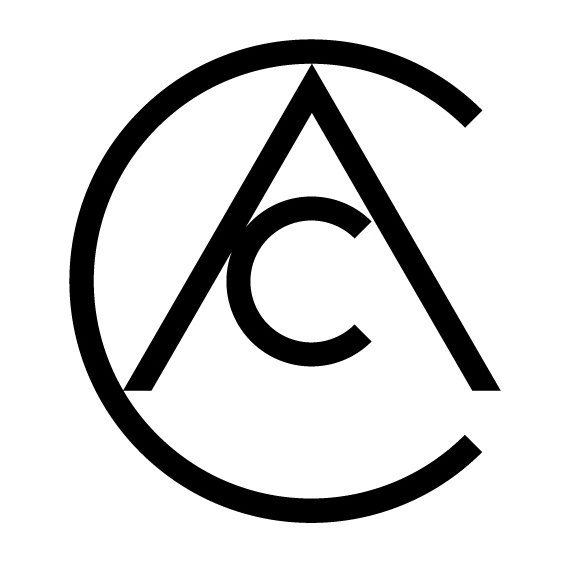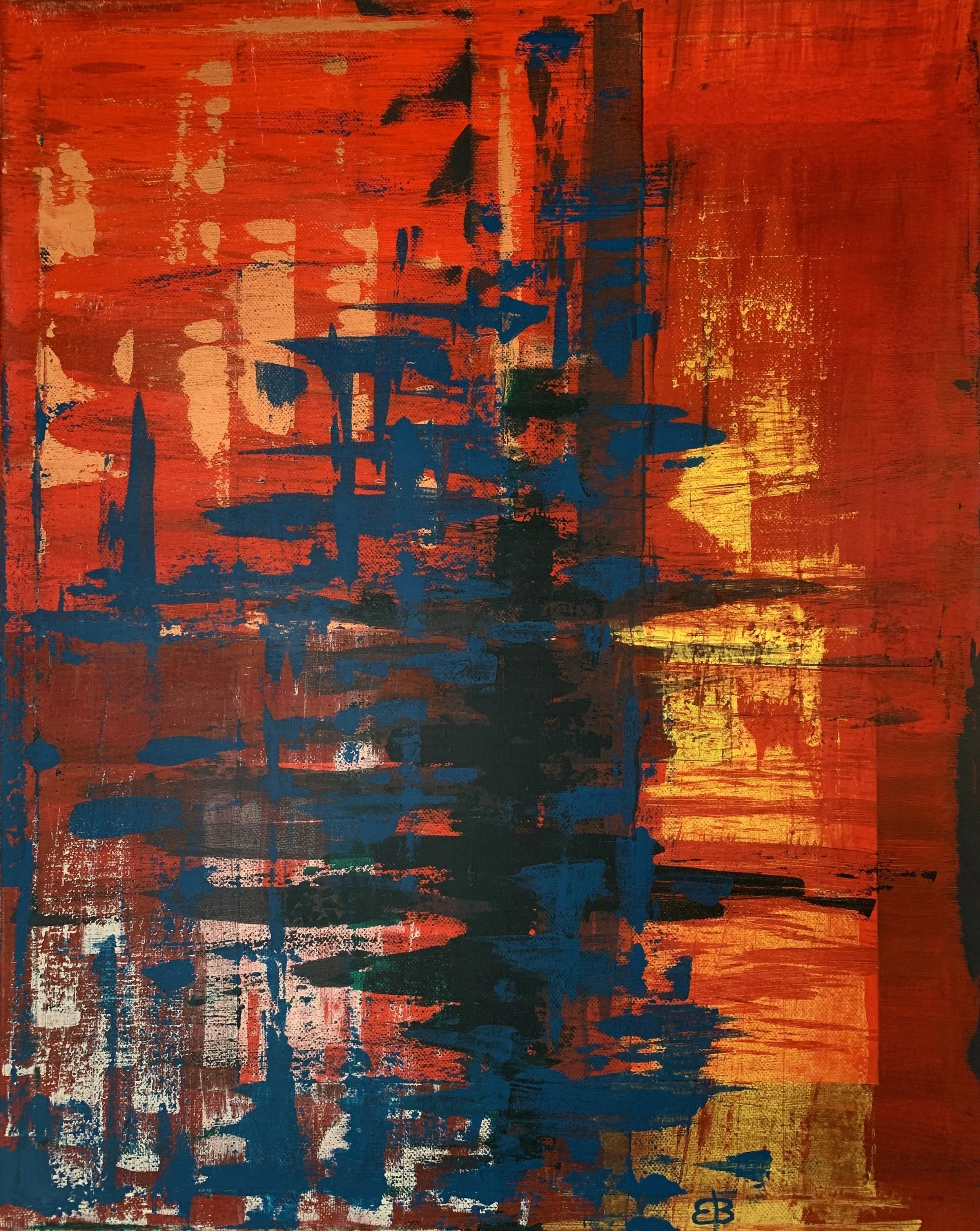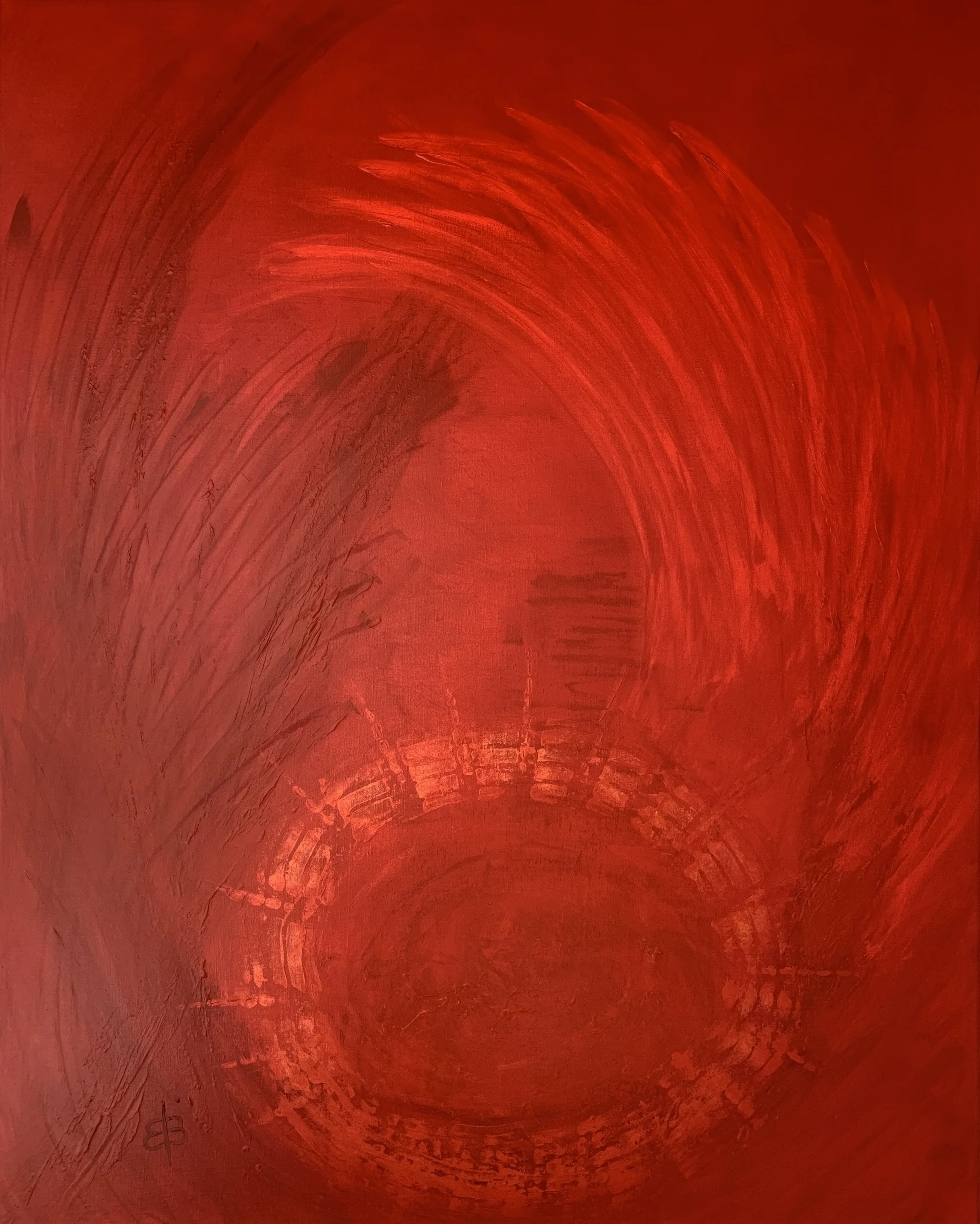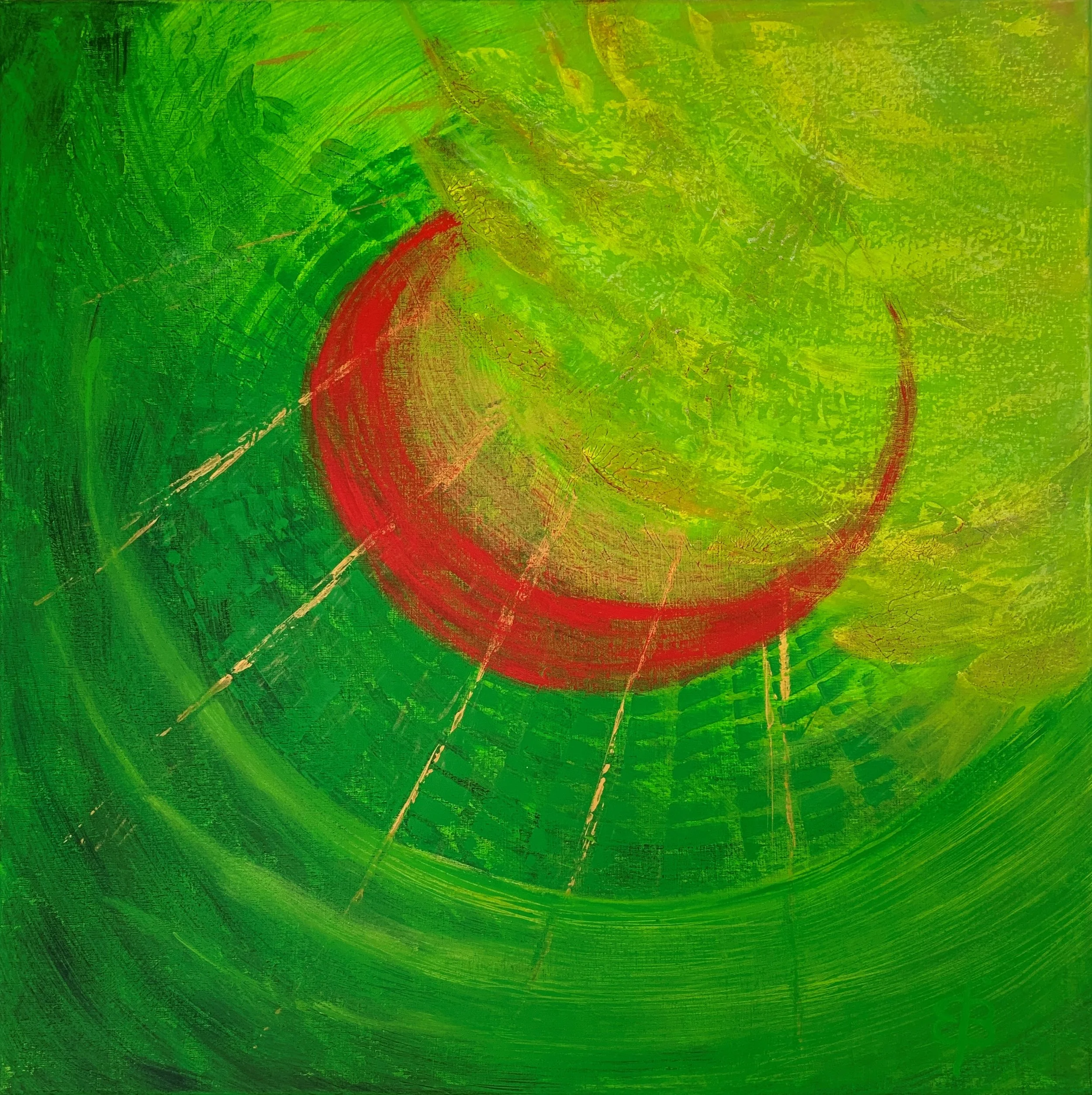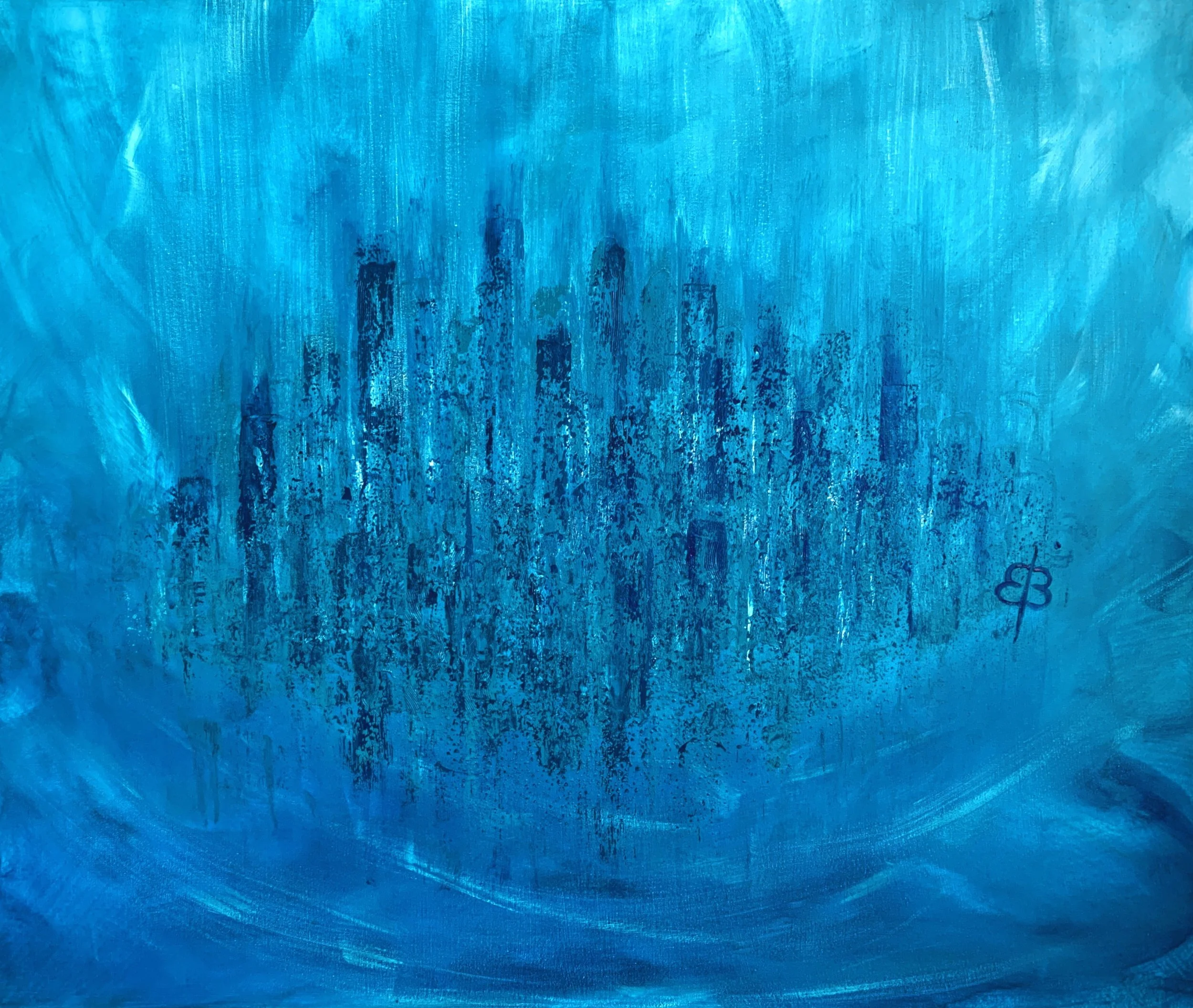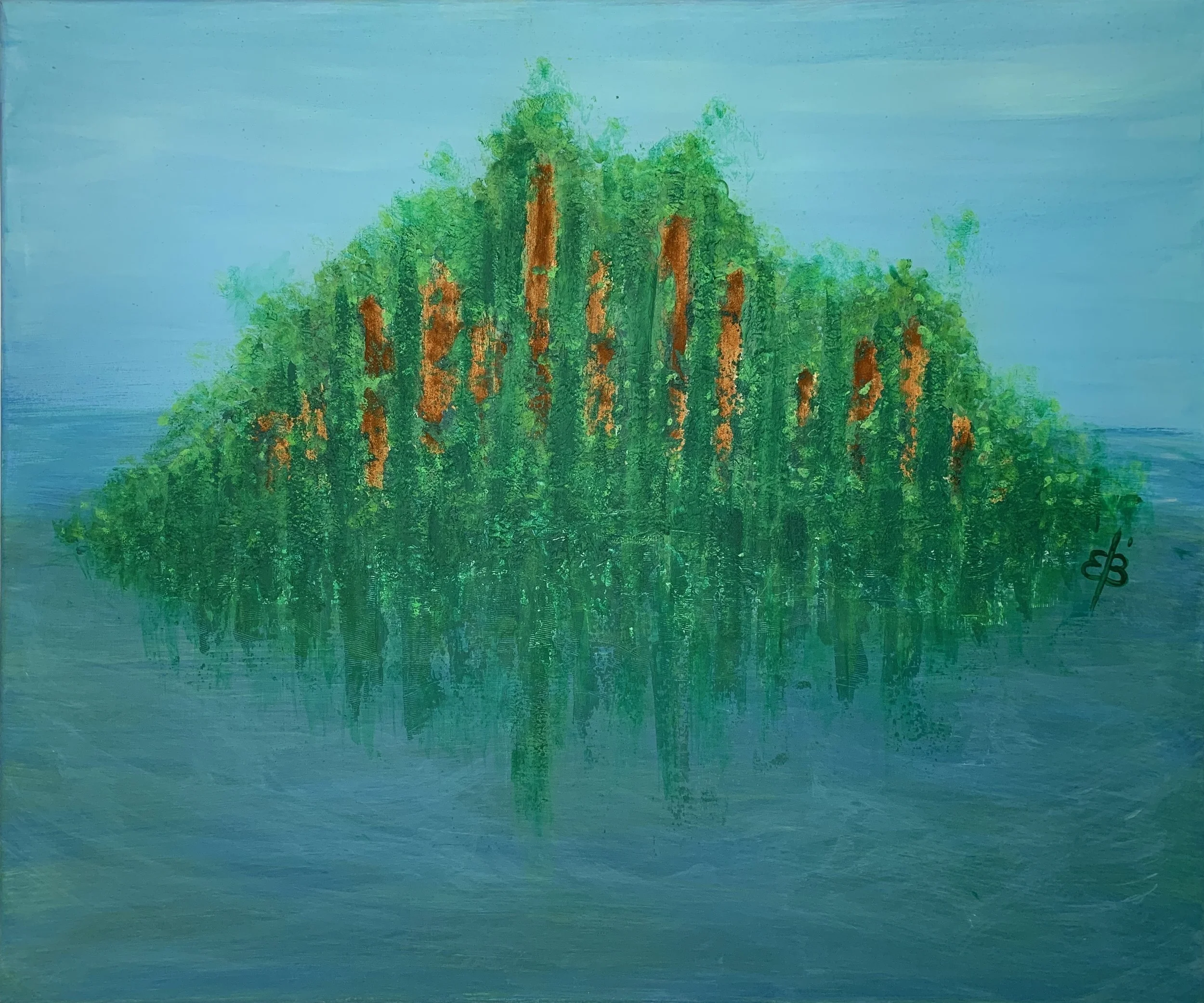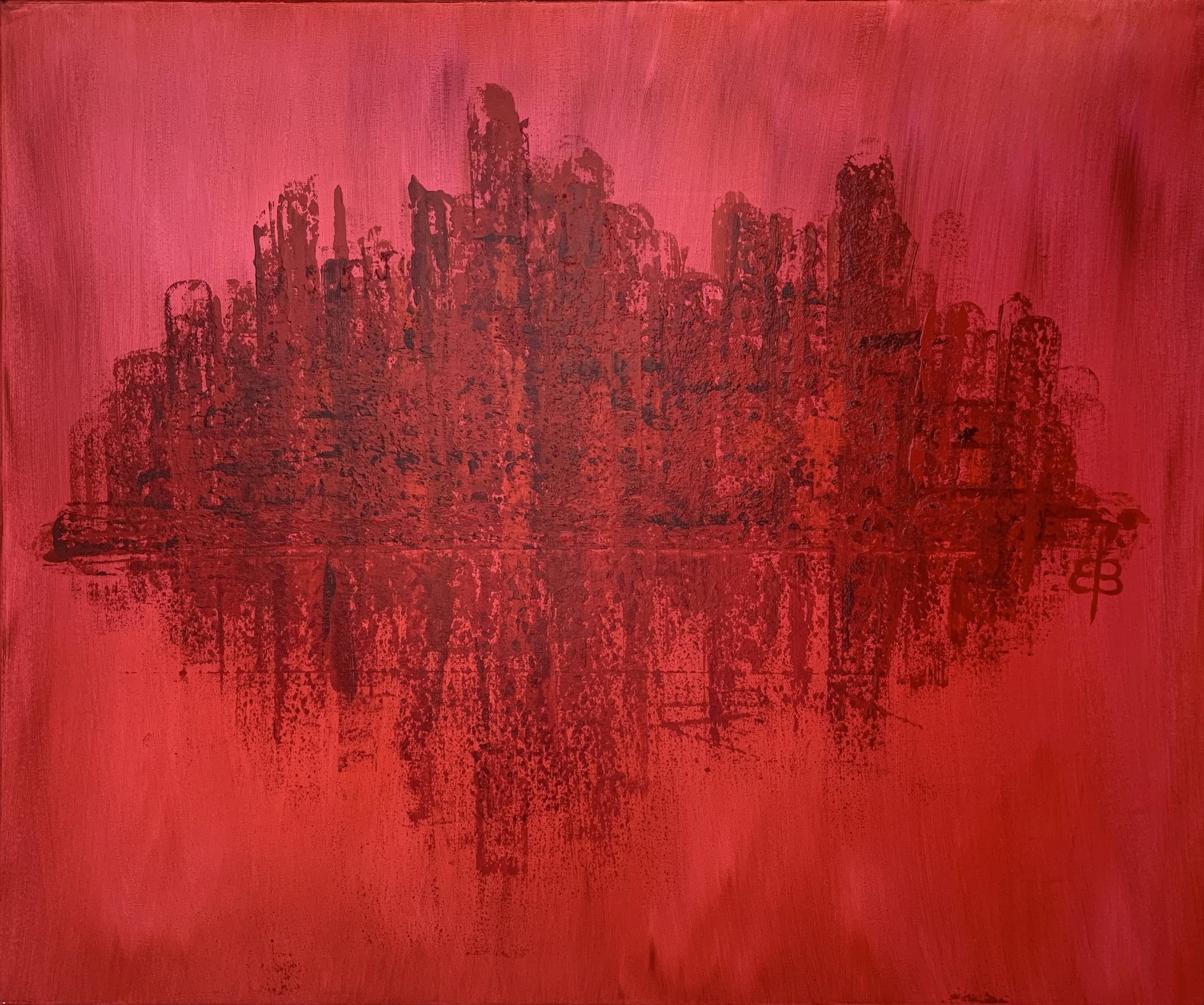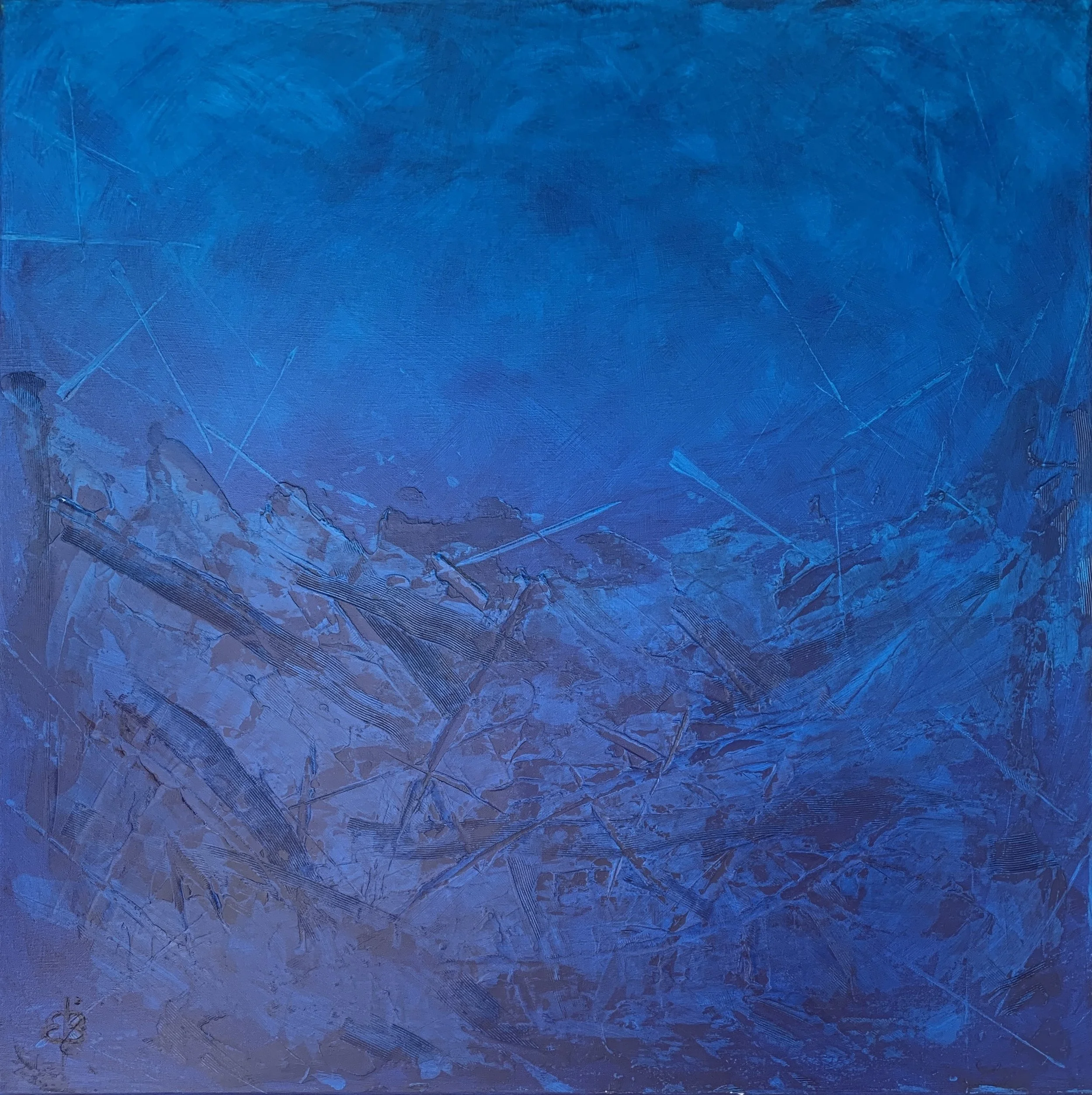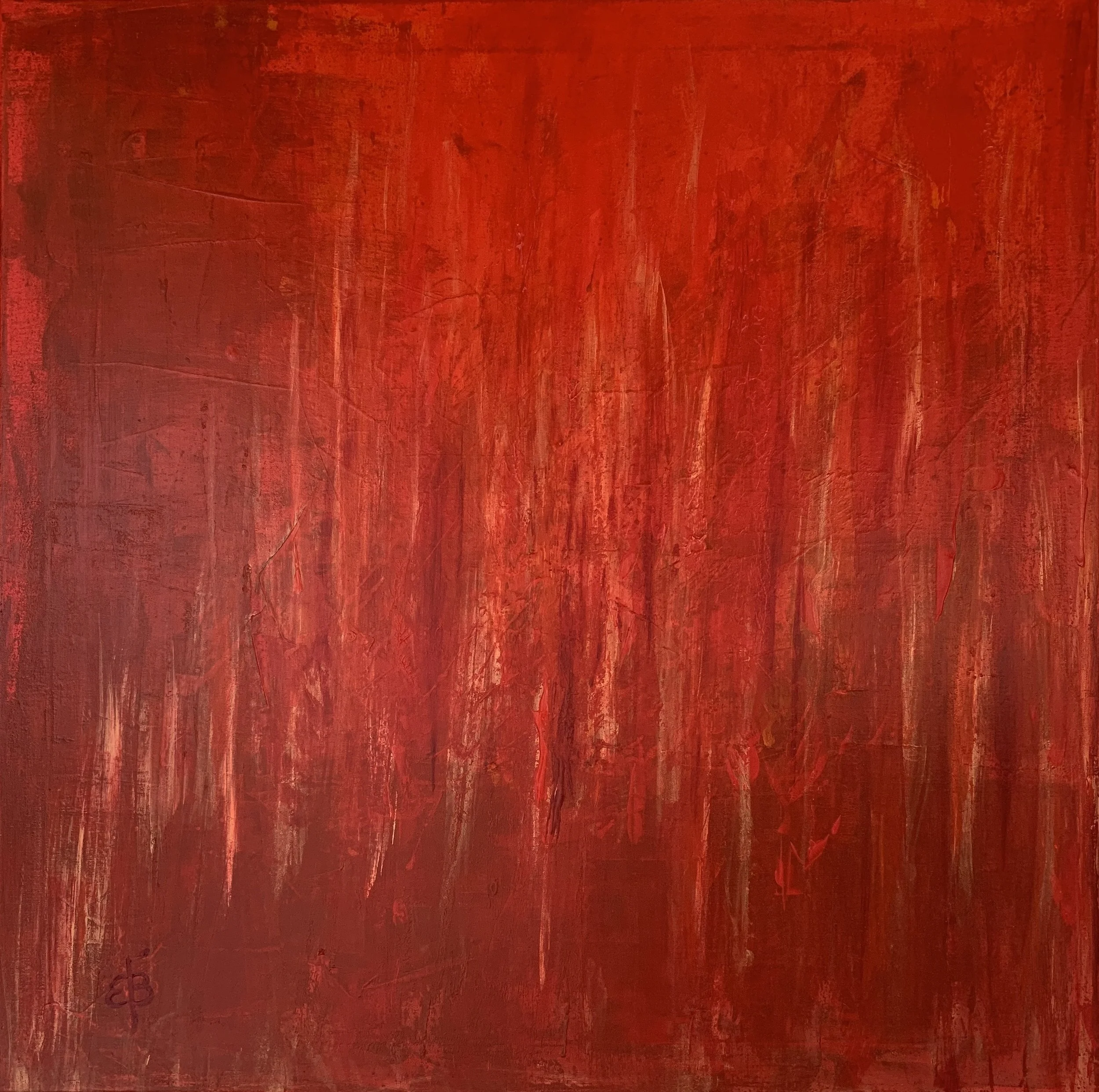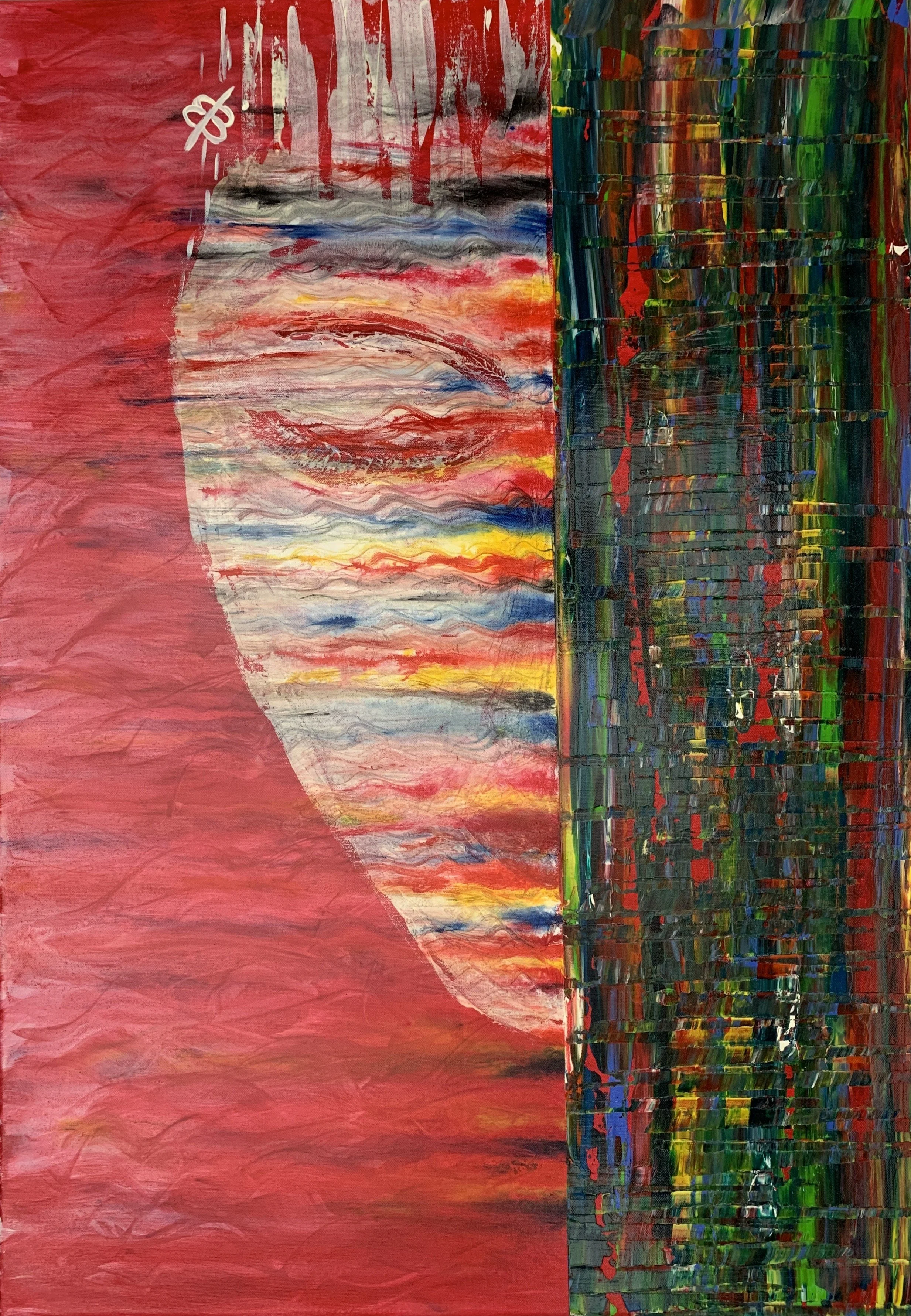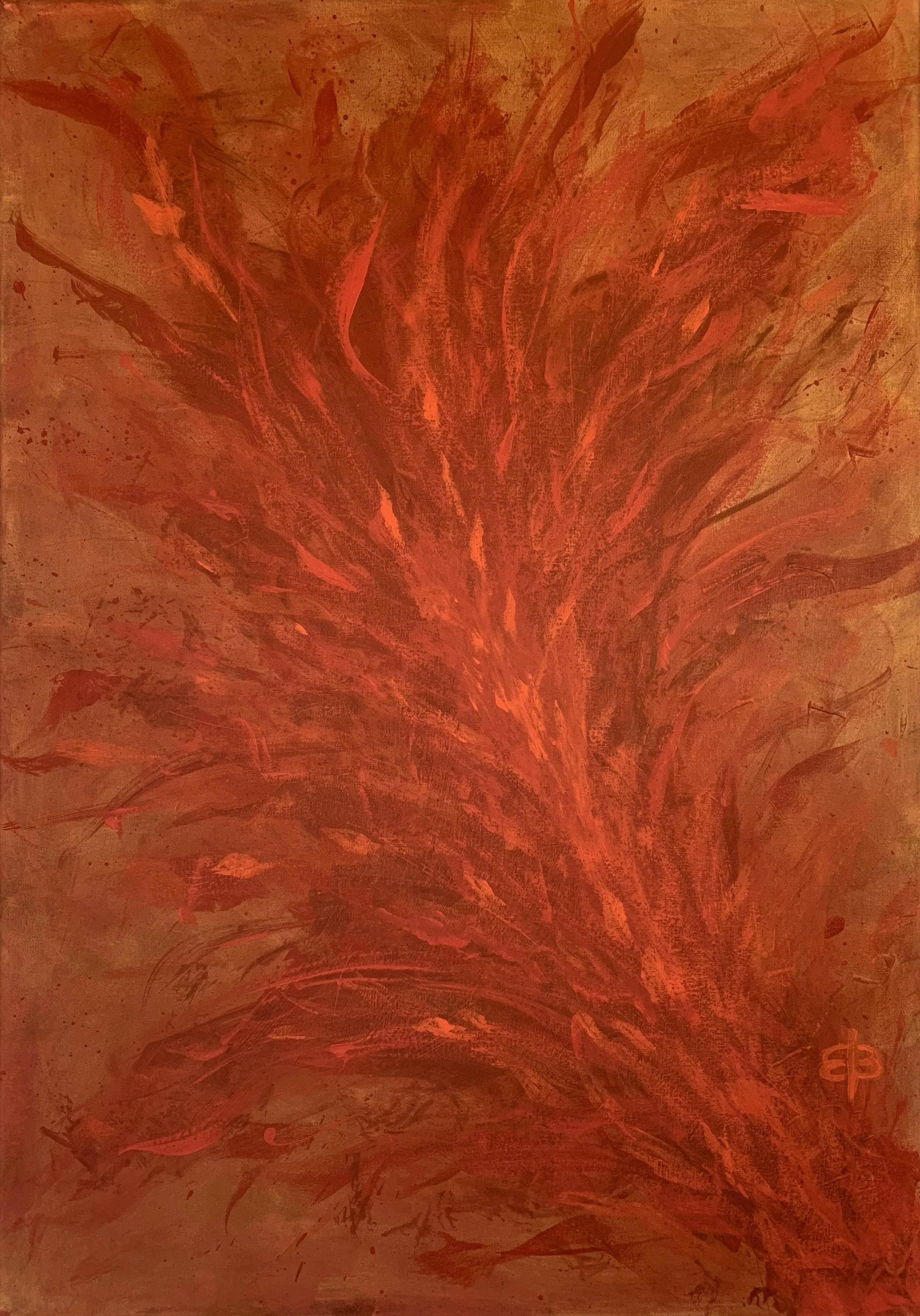Elke Bügler
To enter the world of Elke Bügler is to encounter painting as both an act of surrender and of assertion. It is an art that begins in the void on the blank, unyielding surface of the canvas and moves forward not by premeditated strategy but through an unfolding dialogue between hand, pigment, and surface. Her approach resists linear narrative and predetermined form; it is, in her own words, “non-specific,” and yet this very refusal of the literal opens a field in which emotion, intuition, and thought may find their most direct articulation.
The works do not depict; they resonate. They vibrate with tonal intensity, with the gravity of color fields that appear to pulse outward and consume space. In them, the viewer is compelled to abandon the expectation of figuration and instead to enter into a psychic terrain of suggestion at once personal and universal.
Bügler’s practice is defined by an instinctual beginning: a blank surface, a single dominant color chosen not from a palette of conceptual preplanning but from the deeper reservoir of intuition. Layer by layer, paint is applied, thinned and thickened, brushed, scraped, and reconfigured until the surface achieves not a singular answer but an open-ended condition of presence. What emerges is a work that refuses to be “about” something, but is instead an embodiment of an event of painting as an existential act.
Her canvases testify to the simultaneity of control and release. They are carefully built yet never forced; deliberate yet never rigid. The artist allows the image to come forward of its own accord, acknowledging that painting at its truest is not a matter of imposing will but of facilitating encounter. This method grants her works their extraordinary openness: they exist as spaces for the viewer to project, to imagine, to feel, to remember.
It is in this refusal of specificity that Bügler achieves a paradoxical clarity. To encounter her work is to be reminded that abstraction, at its most powerful, speaks more truthfully than figuration could ever hope to.
If Bügler’s practice begins in openness, it is color that becomes her language of intensity. One painting erupts in searing reds, evoking a visceral energy that borders on the elemental: fire, blood, passion, life-force. Another submerges us in the meditative depth of layered blues, whose cooler tones seem to pull the gaze into a space of introspection, like sinking below the surface of consciousness into a dream. Elsewhere, greens and golds radiate with a vegetal luminosity, conjuring the cycles of nature and the persistence of growth.
Her chromatic fields are not uniform but dynamic, shifting with the modulation of brushwork, with the transparency of glazes that allow one layer to breathe through another. In this, her paintings are not merely about color but about temporality: each canvas records time, the sediment of gestures, the accumulation of decisions both made and unmade.
Hope (2025)
In Hope, a brilliant convergence of green and red arcs into the field, radiating energy like an eclipse in reverse, where light seems not to vanish but to emanate outward. The layered textures and luminous fields seem to oscillate between tension and release, between concealment and revelation. It is a work that speaks to possibility, to the insistence of vitality even in the midst of rupture.
The Imprinting (2025)
Here, painting turns monumental. The surface becomes a vast plane of red intensity, textured and insistent, whose circular forms suggest both cosmic cycles and corporeal traces. The title invites reflection on the way memory and history leave marks not only on the canvas but on consciousness itself. The painting exists as both surface and depth: it is a field of affect in which one feels the weight of the unseen pressing through the visible.
Burning Spirit (2023)
This work channels the primal. In its fiery cascades, we encounter painting not as object but as flame, as combustion. The spirit burns not as symbol but as sensation: the strokes themselves ignite into presence. It is one of Bügler’s earliest mature works, and already it announces her capacity to translate emotion into form with a raw immediacy that is difficult to ignore.
Dimensions (2023)
In Dimensions, the artist offers a more architectural abstraction: blue and red planes interlace, collide, and fracture, producing a sense of spatiality within the flat surface. The work seems to gesture towards the constructed world cities, structures, and grids, yet it resists stabilization into any singular referent. It is as though one were witnessing the material of memory, layered and broken, rather than a concrete depiction.
Into the Blue (2024)
A canvas immersed in deep cerulean tones, Into the Blue resonates with oceanic depth. The surface, textured with subtle ridges and marks, feels geologic, like strata beneath the sea. The work seems to insist on slowness, on contemplation, on the vastness of the inner self. In it, one experiences the sublime not as transcendence but as immersion.
About Passion (2024)
Here, the red dominates, yet it is not the eruption of Burning Spirit. Rather, the vertical striations suggest persistence, endurance. Passion here is not only fire but also duration: the slow burn that continues beyond the flare. It is a reminder that Bügler’s works are never simple; they are not singular statements but layered conditions in which multiple interpretations coexist.
Fading (2023)
A more subdued composition, Fading speaks to transience, to the dissolution of form. The surface seems to recede, as though the image were slipping away even as one gazes at it. It is painting as memory, fragile, elusive, impossible to hold.
Reflection. Nature’s Era (2025)
This painting stages the dialogue between abstraction and figuration. Here we perceive the trace of landscape: verticals of green rising against blue, like a forest island suspended between presence and reflection. Yet it is not landscape as description but as echo, as impression. Nature itself appears as memory, as persistence across time.
Reflection. Sunken City (2025)
In contrast, Sunken City situates us within the ruins of the urban. Blue tones dominate, the forms of a cityscape dissolving into watery reflection. It is a haunting work, suggestive of loss, of civilizations subsumed, of the fragility of human endeavor in the face of elemental forces.
Reflection. What Remains (2024)
Here, the palette turns red, the city rendered as shadow, as afterimage. It is a city remembered rather than seen, a city in ruins, a city that lingers only as residue. The work speaks powerfully to the theme of survival: of what persists when all else has disappeared.
Remarkably, Bügler’s professional career began only in 2023, yet in this short span, she has achieved what many artists labor decades to attain: international exhibitions, prestigious awards, and critical recognition. From Rome to New York, from Istanbul to Zürich, her works have traversed the globe, entering conversations not only about abstraction but about the capacity of painting to embody the interior.
Her awards, among them the International Prize Leonardo da Vinci (2025) and Artist of the Year (2025), affirm the resonance of her work across cultures and audiences. That she has achieved this recognition in such a short time speaks not only to her talent but also to the urgency of her vision.
Within the field of contemporary abstraction, Bügler’s contribution is singular. Where much abstraction has moved toward ironic quotation or conceptual detachment, her work insists on sincerity, on emotion, on the reality of inner experience. She offers not irony but intensity, not distance but presence.
Her refusal of specificity positions her in dialogue with a lineage of abstraction that includes pioneers like Mark Rothko, for whom color was a vehicle of emotion, of the sublime. And yet Bügler is not Rothko’s descendant but his interlocutor. Where Rothko sought transcendence, Bügler insists on immanence: her colors do not open to the beyond but to the within, to the depths of the psyche, to the non-verbal terrain of thought and feeling.
To praise Bügler’s work is not simply to praise its surface beauty or its emotional impact. It is to acknowledge the radicality of her non-specific approach. In a world saturated with images, narratives, and the tyranny of meaning, Bügler offers something profoundly different: a space of openness, where meaning is neither dictated nor denied, but invited.
Her works remind us that painting can still speak in a language beyond language, that abstraction remains vital precisely because it resists closure. They remind us that art need not illustrate; it may instead resonate, reverberate, or open.
Elke Bügler stands as one of the most compelling voices in contemporary abstraction today. Her works, with their luminous fields of color and their insistence on the emotional, carve out a place where painting is not merely an object but an encounter. They invite us to feel without naming, to think without resolving, to dwell in the non-specific as a form of truth.
In this lies her importance, not only for the art world but for society at large. In an age of certainty and over-definition, Bügler offers the gift of ambiguity, of openness, of the space where the unconscious may speak.
Like Rothko before her, she has grasped that color is not secondary but essential, not decoration but revelation. And like Rothko, she has demonstrated that painting, when pursued with sincerity and courage, can still reach into the deepest recesses of human experience.
Elke Bügler is not merely an emerging artist. She is a necessary one, an artist whose voice, carried through the luminous and layered surfaces of her canvases, insists on the enduring capacity of art to move, to question, and to transform.
In the final assessment, what makes Elke Bügler’s work resonate so powerfully is the paradox it embraces: the paintings are non-specific, yet profoundly personal; they refuse representation, yet they feel saturated with lived experience; they deny narrative, yet they speak in the clearest possible voice of human emotion. This balance between openness and intensity is the very core of her contribution to contemporary abstraction.
Her art, in many ways, stages a critique of the contemporary moment. Ours is an age in which art is often harnessed to spectacle, where visual culture is dominated by excess, by instant recognizability, by the currency of images that circulate endlessly and superficially. Bügler’s canvases resist this. They cannot be consumed at a glance; they cannot be explained by a caption or contained within a singular interpretation. Instead, they demand time—time to look, time to feel, time to think. In doing so, they restore to painting its capacity for depth, its ability to function not as entertainment but as meditation, as revelation.
What also emerges across her oeuvre is the sense that Bügler is not merely painting for herself but for the viewer, for the shared space between self and other. By refusing to dictate meaning, she allows the audience to discover their own unconscious responses, their own buried associations. This dialogical quality, the insistence that painting is not a monologue but an exchange, marks her as an artist deeply invested in art’s social role. Her paintings become sites of encounter, where subjectivities overlap, where emotion is no longer private but communal.
In this sense, her practice moves beyond the history of abstraction and into a philosophy of relation. To stand before her work is to be reminded that painting is not dead, nor is it exhausted; it is still capable of touching what is most intimate in us, precisely because it refuses to name it. The red flames, the oceanic blues, the layered greens and golds, all of these speak to conditions that cannot be reduced to words, yet which every viewer recognizes in the body, in memory, in feeling.
Elke Bügler’s rise has been swift, but it is also deeply earned. Her international recognition, her awards, her exhibitions across Europe and beyond, all testify not merely to her talent but to the urgency of her vision. In only a short span, she has established herself as an artist whose work matters, not because it conforms to trends, but because it insists on authenticity, on vulnerability, on courage.
To call her important to contemporary art is not hyperbole; it is a necessity. She reminds us that in a fractured world, art still has the power to unify through feeling, through openness, through the shared acknowledgment of our inner lives. Elke Bügler has given us not just paintings, but spaces of reflection, of emotion, of encounter. In doing so, she has secured her place as one of the most vital voices of her generation, an artist whose canvases will continue to reverberate long after their first viewing, lingering in the mind as an afterimage, as an imprint, as what remains.
By Marta Puig
Editor Contemporary Art Curator Magazine
tyhe Imprinting, 2025, Acryl on Linen, 150x120 cm
Hope, 2025, Acryl on Linen, 100x100 cm
Reflection. Sunken City, 2025, Acryl on canvas, 100x120 cm
Reflection. Nature´s Era, 2025, Acryl on cavas, 100x120 cm
Reflection. What remains, 2024, Acryl on canvas, 100x120 cm
Into the Blue, 2024, Acryl on canvas, 100x100 cm
About Passion, 2024, Acryl on canvas, 100x100 cm
Dimensions, 2023, Acryl on Linen, 100x80 cm
Fading, 2023, Acryl on canvas, 100x70 cm
Burning Spirit, 2023, Acryl on canvas, 100x70 cm
